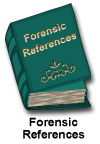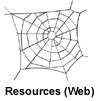|
|
 |
The
required readings for this unit are:
 Australia
Australia |
Required
Reading(s)
|
 |
Insert article
here
 Canada
Canada |
Required
Reading(s)
|
 |
Insert article
here
 International
International |
Required
Reading(s)
|
 |
Insert article
here
 United Kingdom
United Kingdom |
Required
Reading(s)
|
 |
Insert article
here
 United States
United States |
Required
Reading(s)
|
 |
Maeve, M.
K., & Vaughn, M. S. (2001). Nursing with prisoners:
The practice of caring, forensic
nursing or penal harm nursing? ANS, 24(2), 47-64.
Retrieved December 20, 2002, from from Health Source:
Nursing/Academic Edition database:
http://search.epnet.com/direct.asp?an=6682074&db=hch
- Note
- Maeve and Vaughn critically analyze three philosophic
stances toward nursing care with prisoners and
suggest their philosophic commensurability within
traditional nursing practice. A critical hermeneutic
perspective is used to illustrate the issues involved.
|
Databases
For the full text article online,
sleuth the 'University
of Calgary/ Library/ Article Indexes':
Directions:
- Select
- Indexes and abstracts with links to full text articles
- Select
- Academic Search Premier or Expanded Academic ASAP
- Select
- Connect
-
Fill in
User ID and Pin
- Fill
in search words:
- forensic
and philosophy
- forensic
and theory
- prison
- health - theory
Top of Page
|
 |
 |
The
'recommended only' readings for this unit are the following:
 Australia
Australia |
Recommended
Reading(s)
|
 |
Insert article/book/chapter
here
 Canada
Canada |
Recommended
Reading(s)
|
 |
|
Austin,
W. (2001). Relational ethics in forensic psychiatric
settings. Journal of Psychosocial Nursing &
Mental Health Services, 39(9), 12-17. Retrieved
July 22, 2002 from Proquest database.
- The
pressure of the competing demands of custody and
caring shapes the moral climate of forensic settings.
- A
relational approach to health care ethics, requiring
the opening of dialogue, consideration of multiple
perspectives, and attention to context, can guide
nurses as they strive to engage and respect even
their most estranged patients.
- The
core elements of relational ethics include mutual
respect, engagement, and attention to the environment
Evans,
M. (2000). The significance of ethical sophistication.
Journal of Psychosocial Nursing & Mental
Health Services, 38(4), 8-13. Retrieved July
22, 2002 from Proquest database.
- Re-visioning
Nurses' Punitive Attitudes within Forensic Psychiatric
and Correctional Nursing:
Nurses play a significant role in the assessment
and treatment of offenders. Nevertheless, studies
reveal that many nurses hold punitive attitudes
(e.g., favoring retribution) toward offenders
such as child sex abusers (Eisenberg et al., 1987;
Kelley, 1990; Lariviere & Robinson, 1994;
Liaschenko, 1994).
Kent-Wilkinson,
A. (1993). After the crime, before the trial. Canadian
Nurse, 89 (11), 23- 26.
- Note
the philosophical base or the philosophical approaches
the author purports are the practice of forensic
psychiatric nurses (Kent-Wilkinson, 1993, p. 26).
|
 International
International |
Recommended
Reading(s)
|
 |
Insert article/book/chapter
here
 United Kingdom
United Kingdom |
Recommended
Reading(s)
|
 |
Mason, T. &
Chandley, M. (1990). Nursing models in a special hospital:
A critical analysis of efficacy. Journal of Advanced
Nursing, 15, 667-673.
- Note the
overview of the historical laws significant to forensic
psychiatry in England. Note the reference to Florence
Nightingale's holistic concern in the 1800's (Mason
& Chandley, 1990, p. 669).
Mason, T. &
Mercer, D. (1996). Forensic psychiatric nursing: Vision
of social control. Australian and New Zealand Journal
of Mental Health Nursing, 5, 153-162.
- Note the
ideological framework deduced by these authors.
Mercer, D.
(1999). Crime, mental disorder and criminology: A critical
perspective. In: Tarbuck, P., Topping-Morris, B., Burnard,
P.(Eds). Forensic Mental Health. Nursing: Strategy
and Implementation. London, Whurr.
- Note the
historical theoretical evolvement as an explanation
of the relationship between mental disorder and crime.
 United States
United States |
Recommended
Reading(s)
|
 |
|
Melton,
L., Secrest, J., Chien, A., & Andersen, B. (2001).
A community needs assessment for a SANE program
using Neuman's model. Journal of the American
Academy of Nurse Practitioners, 13(4), 178-186.
- The
purpose of this paper is to report the development
of guidelines for advanced practice nurses to
conduct a community needs assessment for a Sexual
Assault Nurse Examiner (SANE) program. These guidelines
were developed from the Neuman Systems Model (Neuman,
1995) and provide a comprehensive, holistic assessment
of a community. Nurses have an important role
to play in the assessment, management and evaluation
of SANE programs.
Spohn,
C., & Holleran, D. (2002). The effect of imprisonment
on recidivism rates of felony offenders: A focus
on drug offenders. Criminology, 40(2), 329-359.
Retrieved December 19, 2002, from Academic Search
Premier database:
http://search.epnet.com/direct.asp?an=6951638&db=aph
- Note:
Deterrence theory, as developed by eighteenth-century
utilitarian philosophers such as Jeremy Bentham
(1948) and Cesare Beccaria (1963 [1764]), suggests
that crime results from a rational calculation
of the costs and benefits of criminal activity:
Individuals commit crimes when the benefits outweigh
the costs.
|
Top of Page
|

|
Additional
references for this unit can be found in 'forensic
references'
of the forensic sourcebooks.
- Sleuth
'forensic reference' database for:
- forensic
- philosophy
- forensic
- theory
- prison
- health - theory
Top of Page
|

|
Video's
recommended for this unit are:
|
|
Resources
(Video)
|
 |
Insert video
here
Top of Page
|

|
The
required websites to sleuth for this unit are the following:
 Australia
Australia |
Resources
(Web)
|
 |
Insert website here
 Canada
Canada |
Resources
(Web)
|
 |
Insert website here
 International
International |
Resources
(Web)
|
 |
Insert website here
 United Kingdom
United Kingdom |
Resources
(Web)
|
 |
Insert website here
 United States
United States
|
Resources
(Web)
|
 |
Fieser,
J. & Dowden, B. (2002). The Internet Encyclopedia
of Philosophy. Retrieved July 13, 2002
from http://www.utm.edu/research/iep/
- Note
this Internet Encyclopedia on Philosophy.
Fieser,
J. & Dowden, B. (2001). Timeline of Western
Philosophy. Retrieved July 13, 2002
from the Internet Encyclopedia of Philosophy Website:
http://www.utm.edu/research/iep/westtime.htm
- Note
the great Western philosophers in history. (i.e..Cesare
Beccaria- Italy)
|
Top of Page
|
 |
For
additional websites on this unit, sleuth 'forensic
websites' in the forensic sourcebooks.
- forensic -
philosophy
- forensic
- theory
- prison - health
- theory
Top of Page
|
 |
|